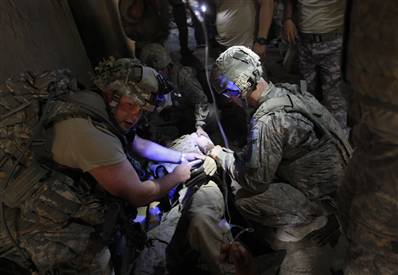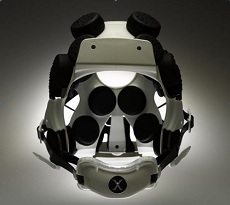American military casualties in Iraq and Afghanistan exceed 500,000 (Part 2 of 2)

A wounded U.S. soldier receives first aid inside a bunker in Bargematal,
Afghanistan, on Tuesday, Aug. 25, 2009. (Photo: Oleg Popov / Reuters)
[Part 1] "American soldiers, sailors, marines and airmen face the worst of two worlds. First, they continue to be supplied with cheap and substandard equipment (which has become a Pentagon tradition), while military contractors and war profiteers linked to Administration officials become rich. Second, when they are injured, their courage and actions are not recognized. Their injuries are many times not treated or acknowledged, and they are abandoned by the country they risked everything to protect. It is a shameful spectacle."
In Afghanistan, the light at the end of the tunnel is an exploding Taliban IED. The Pentagon has been given nine years to win its war and it has failed to do so. Last week the American public was given a status report by Secretary of Defense Robert Gates, who told Time Magazine that he is “pretty confident” that in six months the U.S. military will have made “sufficient progress” in the war.
This vague and hardly inspiring characterization (in which the Secretary commits to nothing) sets the stage for December 2010, at which time the military will cherry-pick positive news, as it minimalizes the bad news. The resulting concoction will be trumpeted as “progress.”
In order to continue to prosecute its lackluster war efforts and to deflect criticism regarding the competence of the military’s general officer corps, the Pentagon long ago realized that casualty rates had to be kept low. As they did not remain low, the statistics were adjusted. The procedure is simple. The Pentagon does not count 95% of the injured soldiers, sailors, marines and airmen as casualties. “Fudging the numbers” was adopted as the solution. All that matters is that Congress continues to fund the Pentagon’s wars.
Two categories of casualties that the Pentagon does not count are traumatic brain injury (TBI) cases and cases of Post Traumatic Stress Disorder (PTSD).
TBI is defined any head injury, concussion or impact resulting in a loss of consciousness. The June 11, 2010, edition of the Huffington Post reported on an unpublished U.S. Army study of 18,305 First Infantry Division soldiers at Fort Carson, Colorado. The study, conducted by Colonel Heidi Terrio, found that 40% of returning soldiers had experienced at least mild TBI. Assuming that 1.5 million personnel have served in Iraq or Afghanistan; that percentage would equate to as many as 600,000 casualties.
PTSD is defined vaguely by the National Institute of Mental Health as an anxiety disorder triggered by one or more traumatic events. Symptoms include fear, flashbacks, numbness, memory loss and sudden anger outbursts. The June 2010, edition of “Archives of General Psychiatry” included a study entitled: “Rates of PTSD or Depression with Serious Functional Impairment” It found PTSD (with serious functional impairment) rates among veterans ranging from 8.5% to 14%. Assuming that 1.5 million personnel have served in Iraq or Afghanistan; that would equate to as many as 200,000 troops being seriously impaired. This does not include cases of PTSD that generate only mild functional impairment, which would add hundreds of thousands of additional victims to the equation.
On January 31, 2008, the New England Journal of Medicine published a study entitled: “Mild Traumatic Brain Injury in U.S. Soldiers Returning from Iraq.” As background, the research paper quotes a U.S. Army study that found that 18% of troops were suffering from mild traumatic brain injury (MTBI) or had experienced a concussion. Those injured reported “persistent post-percussive symptoms” including irritability, loss of memory, headaches and difficulty concentrating. The study found a link between cases of PTSD and instances of TBI.
The numbers in these reports are staggering and the data is heartbreaking. They raise the question: Are these injuries, at least in part, preventable? The Kabul Press has been researching concussion-prevention technology. The results are startling.
What we found is that technology exists to significantly reduce combat-related concussions, but the Pentagon has not adopted them.

The inside lining of the Xenith helmet
shown here is a flexible cap embedded with
shock absorbers, or black discs, intended
to dissipate the energy of a hit and lessen
the sudden movement of the head that
causes concussions. This technology is
years old, but the Pentagon has not adopted
it. Credit: Xenith
The area of most promise is helmet technology. Helmets need to be designed with the goal of reducing both the acute effects of a single trauma incident (such as a bullet ricochet or explosion) along with the chronic effects of repeated and more minor head trauma. The latter can also cause a neurological disorder called chronic traumatic encephalopathy.
Years ago, the sports world moved away from foam padding and gel filled padding and adopted inflatable padding to line the inside of safety helmets. Specifically, manufacturers created helmets that are internally lined with rings of air-filled shock absorbers.
The sports world also consulted medical experts and anthropologists who confirmed that there are numerous human cranial sizes and shapes, therefore one helmet will not fit all. Human cranial capacity ranges from 1200 to 1850 cc’s and there is sexual dimorphism, which means that men and women have different skull ridges, lines, palates, orbits and sinuses. As a result, athletes have turned to custom manufactured helmets configured to meet the individual contours of the wearer. The Pentagon and the U.S. Department of State have, to-date, refused to recognize any of this research. They have instead opted to purchase cheap and outdated helmets in bulk in a few standard sizes. These helmets do not fit appropriately, have no shock absorbers and, therefore, the protection they offer is compromised, potentially severely.
A rare insight into Pentagon thinking on these issues was provided in an e-mail that was leaked to National Public Radio. It was written in April 2010, by Dr. Charles Hoge. From 2002 to 2009, Hoge was the U.S. Army’s senior Army mental health researcher at Walter Reed and he currently is an advisor to Army Surgeon General, Lt. General Eric Schoomaker. He wrote (according to T. Christian Miller of NPR):
“What’s the harm in missing the diagnosis of mild TBI?”
Dr. Hoge was quoted in the Huffington Post on June 16, 2010, as belittling the idea that PTSD is a trauma or an injury. He described it as simply a normal reaction to combat. Hoge, in the same report, dismissed the idea that there might be lingering effects from mild traumatic brain injury. Science has taken a back seat to politics.
While the Pentagon’s bureaucracy pays public lip service to the problems of TBI and PTSD, it is not supportive of any substantive efforts to recognize or reduce these combat injuries.
American soldiers, sailors, marines and airmen face the worst of two worlds.
First, they continue to be supplied with cheap and substandard equipment (which has become a Pentagon tradition), while military contractors and war profiteers linked to Administration officials become rich. Second, when they are injured, their courage and actions are not recognized. Their injuries are many times not treated or acknowledged, and they are abandoned by the country they risked everything to protect. It is a shameful spectacle.
American Military Casualties in Iraq and Afghanistan Now Exceed 500,000 (Part 1 of 2)
___________________________________________________________________________________
Source: http://kabulpress.org/my/spip.php?article16127
URL: http://www.a-w-i-p.com/index.php/2010/06/26/american-military-casualties-in-iraq-and-3
























